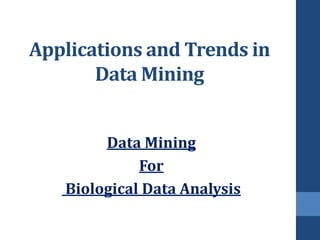
Data mining ppt
- 1. Applications and Trends in Data Mining Data Mining For Biological Data Analysis
- 2. Factors that led for the development • The past decade has seen an explosive growth in: 1.Genomics 2.Proteomics 3.Functional genomics 4.Biomedical research • Identification and comparative analysis of genomes of humans and other species for investigation of genetic networks. • Development of new Pharmaceuticals and advances in cancer therapies.
- 3. • DNA sequences form the foundation of genetic codes of all living organisms. • DNA sequences are comprised of four basic building blocks called nucleotides: 1.adenine (A) 2.cytosine (C) 3.guanine (G) 4.thymine (T) • These four nucleotides (or bases) are combined to form long chains that resemble a twisted ladder.
- 5. • DNA sequence … CTA CAC ACG TGT AAC … • A gene usually comprises hundreds of individual nucleotides arranged in particular order. • A genome is the complete set of genes of an organism. • Genomics is the analysis of genome sequences. • A proteome is the complete set of protein molecules present in a cell, tissue, or organism. • Proteomics is the study of proteome sequences.
- 6. Data mining may contribute to the biological data analysis in the following aspects.
- 7. Biological data mining has become an essential part of new research field called bioinformatics.
- 8. 1)Semantic integration of heterogeneous, distributed genomic and proteomic data bases. • Genomic and proteomic data sets are often generated at different labs and by different methods. • They are distributed, heterogeneous, and of wide variety. • Integration of such data is essential to cross-site analysis of biological data . • Such integration and linkage analysis would facilitate the systematic and coordinated analysis of genome and biological data.
- 9. • This has promoted the development of integrated data warehouses to store and manage derived biological data. • Data cleaning, data integration, reference reconciliation, classification, and clustering methods will facilitate the integration of biological data and the construction of data warehouses for biological data analysis.
- 10. 2)Alignment, indexing, similarity search, and comparative analysis of multiple nucleotide/protein sequences. • BLAST and FASTA, in particular, are the tools for the systematic analysis of genomic and proteomic data. • Biological sequence analysis methods differ from many sequential pattern analysis algorithms proposed in data mining. • For protein sequences, two amino acids should also be considered a “match” if one can be derived from the other by substitutions that are likely to occur in nature.
- 11. • There is a combinatorial number of ways to approximately align multiple sequences: 1)reducing a multiple alignment to a series of pair wise alignments and then combining the result. 2)using Hidden Markow Models or HMMs. • Multiple alignment can be used to identify highly conserved residues among genomes and they can be used to build phylogenetic trees to infer evolutionary relationships among species. • Genomic and proteomic sequences isolated from diseased and healthy tissues can be compared to identify critical differences between them. • Sequences occurring in the diseased samples may indicate the genetic factor of the disease.
- 12. 3)Discovery of structural patterns and analysis of genetic networks and protein pathways. • Protein sequences are folded into 3D structures, and such structures interact with each other based on the relative position and distances between them. • Such complex interactions lead to the formation of genetic networks and protein pathways. • It is important to develop powerful and scalable data mining to discover patterns and to study about regularities and irregularities among complex biological network.
- 13. 4)Association and path analysis: identifying co- occurring gene sequences and linking genes to different stages of disease development . • Many studies have been focused on comparison of one gene to another. • Most diseases are not triggered by a single gene but by a combination of genes acting together. • Association analysis methods can be used to determine the kinds of genes that are likely to co-occur in target samples. • A group of genes may contribute to a disease process, here path analysis is expected to play an important role.
- 14. 5)Visualization tools in genetic data analysis. • Alignments among genomic or proteomic sequences and interactions between them can be expressed in 1)Graphic forms. 2)Transformed into various kinds of easy-to-understand visual displays. • They facilitate pattern understanding, knowledge discovery, and interactive data exploration.
- 15. Thank you
